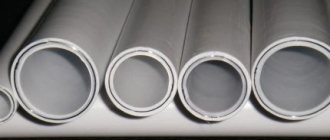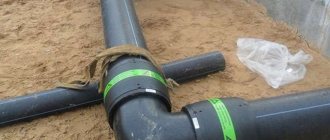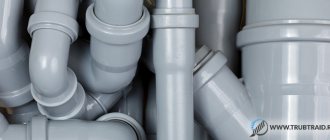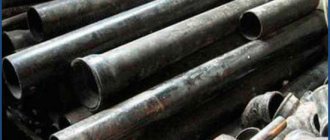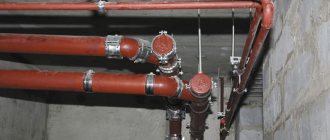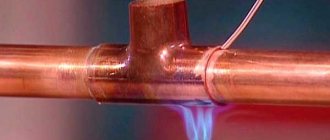During the Soviet Union, cast iron pipes were used to make sewage systems. They have many advantages, such as long service life and high reliability. However, they do not have flexibility, which is why they become overgrown with plaque from the inside and are also susceptible to corrosion. Therefore, in our time, products made of polymer materials are increasingly used. But despite this, most houses still have cast iron pipelines, because most buildings were built several decades ago. Therefore, gradually people begin to independently replace failed areas. At the same time, they are faced with the fact that the pipes are caulked. You should study the question of how to caulk a pipe with your own hands.
Tools and materials required for pipe caulking
Which tool will be used to dismantle sewer elements with your own hands depends on the material used for embossing.
Basically you should have on hand:
Embossing tool
- grinder - used for cutting a piece of pipe;
- cutting and grinding discs;
- protective mask, goggles, headgear (in case of caulking pipes connected by sulfur);
- blowtorch – required for heating;
- hammer, screwdrivers of various lengths and thicknesses;
- pipe wrench;
- chisel.
Grinder and blowtorch
If you are dealing with cast iron elements, then your arsenal should include: a hammer drill, a chisel/steel wedge, a crowbar or nail puller, a pipe cutter, and an iron bucket filled with water.
Before you start work, it doesn’t hurt to draw up an action plan, which depends on how the sewer pipes are connected.
Hammer
Connection methods
The assembly of cast iron pipelines is a complex and responsible task. There are several types of connections:
- into the bell This is the most popular type, which is called “caulking of sewer pipes.” The process requires accuracy and experience, strict adherence to technology requirements. Proper caulking can withstand several decades of leakage use;
- coupling connection. This option is used for socketless pipes. Special couplings are used that tightly grip the edges of the elements being connected. The build quality is high; no special experience or skills are required to complete the work. However, the necessary conditions for installing the coupling are not always available.
There are couplings that are not equipped with threaded clamps. They consist of two sockets into which the ends of the elements to be connected are inserted. Assembly of such lines also requires stamping of sewer pipes, performed using standard technology.
The procedure consists of filling the socket gap with a sealant and sealing it using hardening compounds. The sealant most often used is tarred hemp strand, which is stuffed into 2/3 of the socket and thoroughly compacted. The remaining third is then filled with a durable protective compound. For this purpose, cement and plumbing sulfur are used. Lead caulking is sometimes used in pressure lines, a complex but very effective procedure.
How is cast iron disassembled?
If you are going to completely dismantle a cast iron pipe structure in order to replace it with a plastic one, you can break it with a hammer.
This will not be difficult, because the material itself is very fragile. But if you plan to disassemble a specific part, then you should resort to more loyal methods.
Before dismantling a cast iron sewer system, you need to inspect the entire system and clearly determine which area requires repair.
Afterwards, the water supply is turned off, so no waste will flow into the sewer.
Further:
Cutting off the required section of pipe
- the section of the pipe that is located below the connection is cut off;
- then the pipe and the socket must be disconnected. The methods of caulking will be described below;
- if the connection is difficult to dismantle, then you can use a blowtorch or make surrounding cuts 20 mm long.
Dismantling a cast iron sewer using a lamp
Considering that dismantling cast iron sewers with your own hands can be traumatic, do not neglect protective equipment and safety rules.
Caulking of pipes connected by sulfur
Replacing a sewer system, the components of which were connected by sulfur during installation, begins with the following actions:
Caulking of pipes connected by sulfur
- water supply shutdown;
- disconnecting the hose that leads to the toilet flush barrel;
- completely remove the plumbing fixture by unscrewing the bolts;
- empty the bathroom of furniture and appliances.
Answering the question of how to hammer out a cast-iron sewer connected by sulfur, it is worth noting that due to its properties this process is quite complex.
The best way to determine whether sulfur has been used or not is to hold a blowtorch to the pipe.
The peculiarity of sulfur is that at high temperatures it begins to melt, which is accompanied by the appearance of an unpleasant odor.
Molten sulfur
How to dismantle a cast iron sewer:
- First, a pipe is selected that is located far from the riser. Use a hammer to break it; it is better to use a tool with a polymer or plastic base, because metal attachments lead to sewer clogging.
Break a cast iron pipe with a hammer
- As soon as a cross is discovered that leads to the riser, it needs to be loosened.
Cast iron cross
- At this time, a gas burner or blowtorch is prepared. This stage of dismantling requires the participation of two people. One allows the sulfur to warm up, melting it gradually, and the other at this moment loosens the pipe. Don't forget to use protective equipment (gloves).
Personal protective equipment
- Once the connecting substance has completely melted, the cross can be removed from the cast iron riser. You need to be especially careful when manipulating pipes that are connected to a tee.
Removing sulfur residues and cooling the tee
As you can see, figuring out how to dismantle a cast iron sewer is not at all difficult.
The main thing is to remember to remove any remaining sulfur from the riser and let it cool.
If the cast iron system turns out to be seriously strong, then you can make cuts around the pipe that needs to be removed. This will make it easier to remove it from the riser. Failed to disassemble the pipeline?
Simply connect it to plastic pipes, and this can be done using adapter couplings.
The use of cast iron pipes in pipelines of apartment buildings
Recently, plastic has been widely used, but cast iron has been and remains the main material for constructing sewer networks. Its main advantage is durability. It should not be forgotten that the strength characteristics of cast iron are associated with fragility. These features must be taken into account when minting cast iron pressure pipes. In addition to the above, cast iron products are superior to plastic in the following qualities:
- rigidity;
- wear resistance;
- ability to withstand temperature changes;
- fire resistance;
- low noise level.
Cast iron pipes GOST 9583-75 are used not only in the sewerage system. They are used: in the manufacture of water supply networks, in heat supply pipelines for residential buildings, in fire extinguishing systems. Many residents are in no hurry to abandon heat-intensive cast iron radiators.
The process of dismantling pipes connected by cement and cable
When discussing how to dismantle an old cast iron sewer connected with cement, it is worth noting that the process is not much different from the above, but is safer.
This is explained by the fact that sulfur releases carbon monoxide during melting.
And it all starts with cutting off a certain part of the cast iron pipe, for which you need to step back from the disconnection points by about 30 cm.
The hardened cement is knocked down using a hammer, which needs to be hit on a screwdriver inserted into the hole.
Dismantling the connection with cement and cable
It is important to know that you should not rush in this matter, because you may damage the bell.
After breaking the cement at the joints:
- you should try to loosen the main pipe. If you are interested in how to disassemble a cast-iron sewer without heating, then know that it is possible to remove the heel;
- If you can’t loosen the pipe even without a heel, then strong heat or a special wrench will help. For example, for pipes with a diameter of 50 mm you need tool No. 3, No. 4, but for a tee you will need another pipe.
This is what a heel looks like
The entire dismantling process may take varying amounts of time. Some people manage to cope with this task within one hour, while others need to spend the whole day.
We remove the cast iron tee correctly
The cross is located at the very bottom of the main riser.
You can extract it from there in a variety of ways.
- Using a screwdriver and a hammer, the whole process consists of gently tapping the tee for some time until a gap forms between it and the pipe. Then, using a screwdriver, you go deep into it and use the prying method to remove the old tee. The disadvantage of this method is its length and often ineffectiveness; you can read about this on the forum.
Using a screwdriver and hammer
- Heating method involves using a torch or blowtorch. Everything happens much faster, but you have to pay for it with an unpleasant smell in the apartment. First of all, the bell of the cross is cut off, after which a heating device is inserted into the pipe. To regulate the draft in the riser, a metal shield is placed on the upper section of the pipe. During the heating process, watch how the pipe swings; as soon as this begins to happen, the tee can be removed.
Warming up the tee
- Using a grinder, pieces of the tee are first cut off, after which a small piece of it remains in the pipe. Next, take a disk of small diameter, which fits freely inside. The residual parts of the cast iron product are cut through with a grinder, and they are knocked out using a hammer.
Using a grinder
You still haven’t decided how to remove the cast iron sewer tee, then choose the third method, it is the most reliable and effective.
Now you understand how to dismantle a cast iron sewer, and that this is done in several stages.
If you know how to handle electrical appliances and also follow the safety instructions, you will cope with this task, which may seem difficult at first glance.
We analyze the internal wiring
This stage usually takes the least time. There is no point in keeping the pipeline inside the apartment intact, so there is no need to disassemble it. It is enough to simply cut off the outlet leading to the bathtub, sink and other plumbing fixtures using a grinder, and then saw or split it into smaller pieces and take it out of the apartment.
Dismantling the riser
Dismantling the riser must be done with extreme caution. First of all, you need to make a couple of horizontal cuts in the upper part of the pipe, at a distance of 10–15 cm from the ceiling
You should not saw through the pipe completely; it is better to leave a section of 3–5 cm in size intact. Then carefully knock out the ring formed between the cuts with a sledgehammer.
Next, the section is sawed from below at a distance of about half a meter from the tee/cross. After this, remove the clamps that secure the pipe to the wall. Then the section is split off along the saw line, removed from its place and removed from the room.
Tee analysis
The procedure for dismantling the tee/cross will depend on how its joint with the lower section of the sewer pipe is sealed. If cement is used as a sealant, the fan outlet is carefully loosened using a crowbar. During the process, you can try to break off and remove small pieces of cement putty using a narrow screwdriver. If the cement layer is very thick, knock it down with a hammer and chisel. Having removed the bulk of the putty, the crosspiece is carefully removed from the socket.
If the tee is sealed with sulfur, in order to remove it, it is necessary to heat it for a long time with a blowtorch or hairdryer. When heated, the sulfur putty will melt. The tap must be constantly loosened little by little to speed up the melting process. As soon as possible, it is removed from the socket.
If the fan outlet cannot be manipulated, it is simply cut off with a grinder at a distance of 5–6 cm from the lower socket. The remaining part of the riser is then cleaned, and new pipes are connected to it using special adapters.
Repairing a deteriorating sewer system. The technology of caulking depends on the method of connecting the joints (type of seal): cement ones are carefully broken with a hammer, heated with sulfur with a blowtorch. It is more difficult to disassemble than a recently assembled one, since over the years it rusts and the thickness of deposits increases. In any case, this is a labor-intensive process, cast iron, with all its advantages, it is a brittle material and breaks under the direct application of force.

